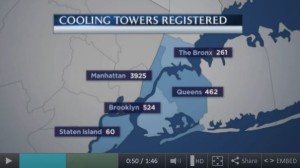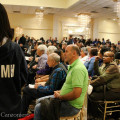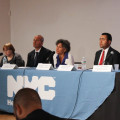 Weeks after the Legionnaires’ outbreak was declared over in a large swath of the South Bronx after claiming 12 lives and infecting more than 120 people, a small cluster was discovered the following day at Melrose Houses, NYCHA development. Four people were sickened, treated and later recovered.
Weeks after the Legionnaires’ outbreak was declared over in a large swath of the South Bronx after claiming 12 lives and infecting more than 120 people, a small cluster was discovered the following day at Melrose Houses, NYCHA development. Four people were sickened, treated and later recovered.
After the plumbing systems in several buildings were outfitted with Copper-Silver ionizer filters, Bronxites were led to believe that the outbreak was isolated. But by September 7, a Morris Park resident was already sickened with Legionnaires’ disease.
By September 30, thirteen persons in the Morris Park neighborhood have taken sick. One person has died. Nine are currently hospitalized; three have been discharged. The infected patients range in age 45 t0 75 and have underlying health conditions, e.g., COPD, smoking risk, depressed immune systems. Presently, the number of Emergency Department visits for pneumonia shows no increase above usual levels.
In a move unlike his reaction to the August outbreak in the South Bronx, Mayor Bill de Blasio appeared at the Morris Park Civic Association where he visited with seniors and local politicians on Wednesday. He encouraged the seniors to see a doctor if they are not feeling well. Health Commissioner Dr. Mary Bassett, Assemblymembers Marcos Crespo, Michael Benedetto and Mark Gjonaj, and Councilman James Vacca accompanied Mayor de Blasio. State Senator Jeff Klein sent his chief of staff.
According to the pool reporter, Mayor de Blasio and Dr. Bassett They said that since City Council legislation was passed that mandated the testing and cleaning of cooling towers, all of these towers were previously cleaned and have been since cleaned again following the positive tests. Dr. Bassett said Legionnaires’ thriving in warm weather can be blamed for the new outbreak.
Mayor de Blasio repeatedly said the City Council legislation is the “strongest in the country.”
The Mayor and Dr. Bassett stressed this is a much more “limited” and different outbreak than what we saw in the South Bronx. This is “different than what we experienced a couple of weeks back in the South Bronx. This is a much more limited situation,” de Blasio said.
According to a Department of Health (DOHMH) timeline:
- The first case was reported on 9/21 prompting an immediate investigation – interviewing patients and reviewing medical records
- Area Emergency Rooms alerted to look for pneumonia cases, September 21
- SDOH Commissioner Zucker notified Saturday, September 26
- 35 cooling towers in MP were sampled on Saturday and Sunday, 9/26-27
- Health Alert distributed to providers on Monday, September 28
- Centers for Disease Control consulted Monday, September 28
- 15 cooling towers tested positive for legionella, Tuesday, September 29
 The infected cooling towers serve five hospital facilities, a local high school and a bank. Some buildings have multiple towers.
The infected cooling towers serve five hospital facilities, a local high school and a bank. Some buildings have multiple towers.
Classes at Lehman High School remained in session while the A/C system was disinfected because the water in the cooling tower is self-contained and separate from water used by students.
All fifteen infected locations were cleaned and disinfected immediately. As stated earlier, those towers were previously cleaned under the Commissioner’s August 6 order directing the citywide cleaning and disinfection of all cooling towers.
“Previously, some scientists have criticized the reactive approach espoused by the CDC believing that sources for Legionella could be determined with pro-active environmental testing followed by disinfection,” said Robert E. Herriman, Jr., editor-in-chief, Outbreak News Today.
There are now many questions about the presence of legionella bacteria in cooling and plumbing systems in the Bronx and elsewhere. Also, the Morris Park outbreak (that the DOHMH is euphemistically calling a “cluster”) calls into question the efficacy of the recently enacted city law requiring quarterly inspection and treatment of cooling towers.
NBC News 4 reported that City registration records show that there are 5232 cooling towers citywide with 261 in The Bronx and nearly 4,000 such units in Manhattan. That’s 20 times the number of cooling towers yet Manhattan hasn’t experienced the same or greater level of Legionnaires’ disease as the Bronx has since January.
Earlier this month, Bronxites living at Melrose Houses were told that copper-silver ionizer filter would disinfect and control legionella, the bacteria responsible for Legionnaires’ disease. Many are now asking, “is the legionella controllable?” and “Why the Bronx?”
Mr. Herriman stated, “it’s not just the Bronx, but nationally. Cases in the US have quadrupled since 2001 and the increase is not likely to be solely due to better physician awareness.”
Local elected officials and community leaders find the city’s response adequate but remain concerned about the spread of Legionella and are guarded about the effectiveness of measures undertaken.
In an email, a spokesman for the Centers for Disease Control acknowledged that the agency is aware of and consulting with the New York City Department of Health and Mental Hygiene on the Morris Park cluster of cases of Legionnaires’ disease.
Asked about the measures taken, the spokesman responded, “The CDC is always concerned about cases and outbreaks of Legionnaires’ disease when they occur, but NYC is taking appropriate steps to control the outbreak.”
Community outreach by the health department has included identifying and visiting locations of vulnerable populations, such as senior centers. Calls have been made to Morris Park residents to provide details about the illness and to answer questions. On Tuesday evening, DOHMH held a Teletown Hall for residents.
A informational town hall will be held at Maestro’s Caterers on Thursday, October 1, 8 PM.
Legionnaires’ disease is not contagious and is easily treatable with antibiotics. Adults with flu-like symptoms, such as fever, cough, or difficulty breathing, should seek immediate medical attention.



















Follow Us